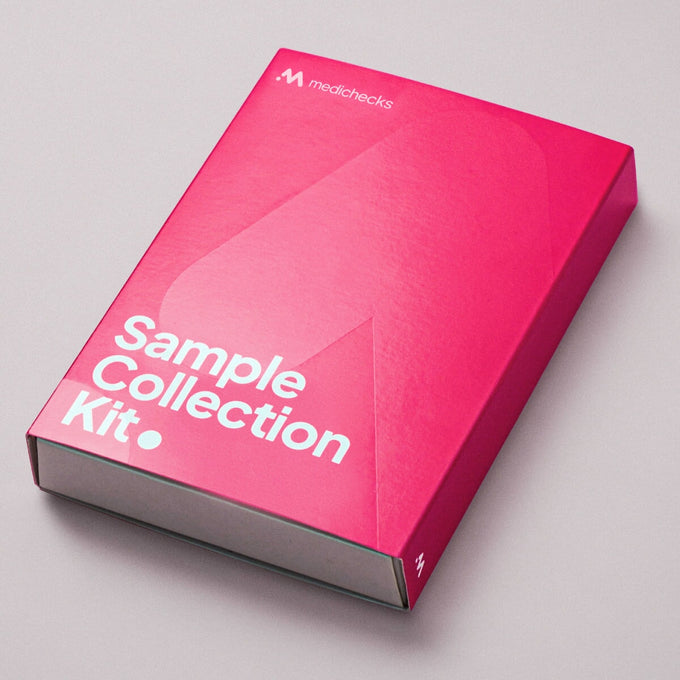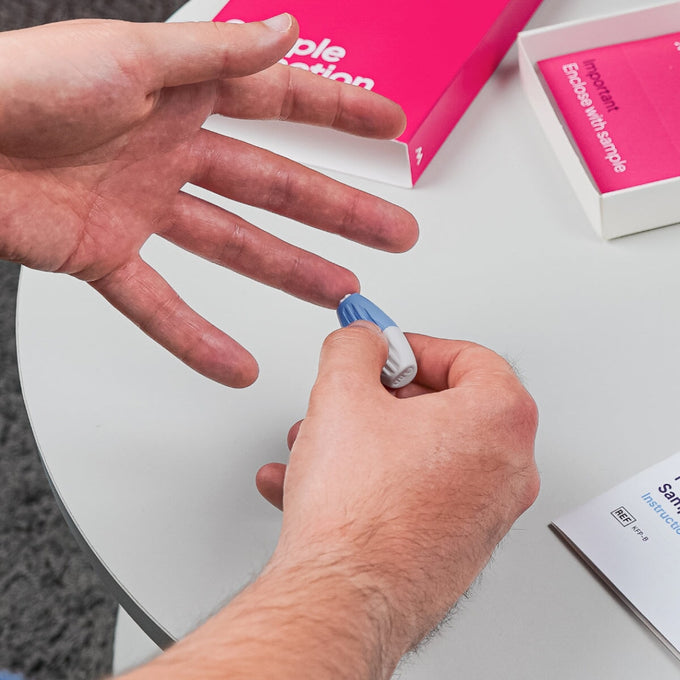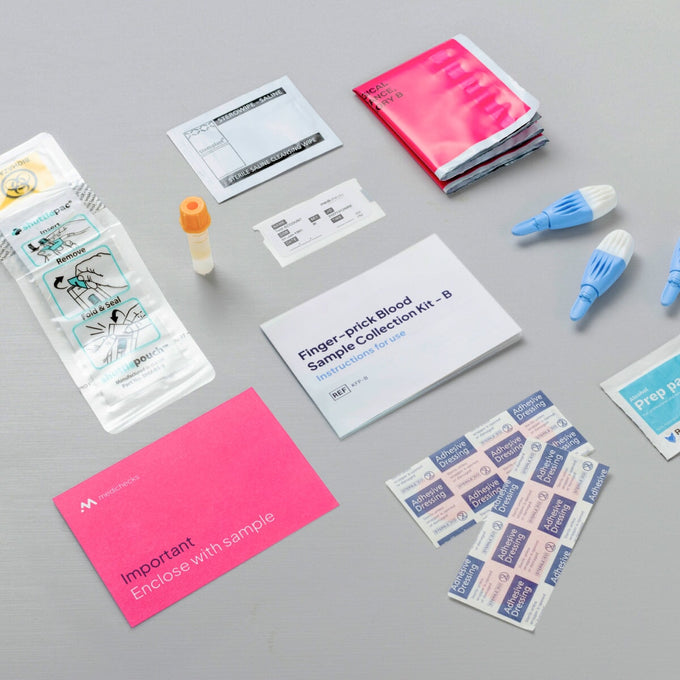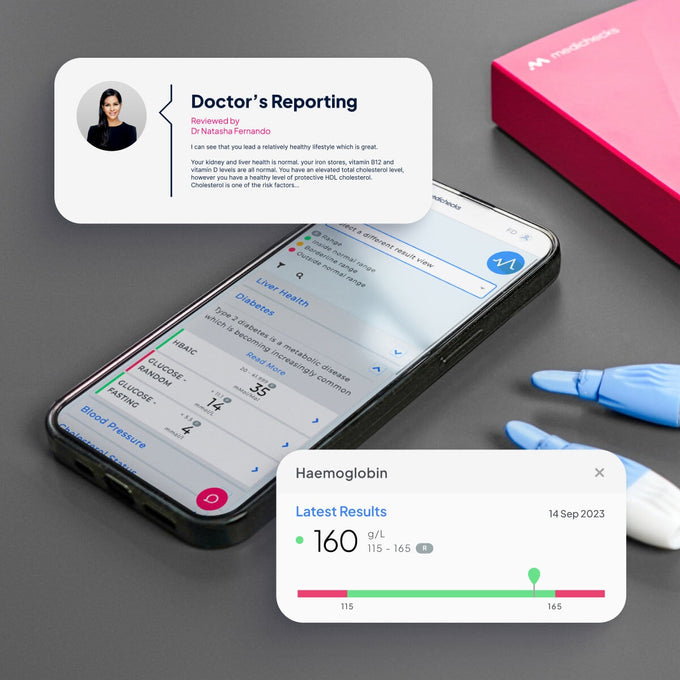Male Hormone Blood Test, from our experts to you.
Dr Sam Rodgers MBBS, MRCGPChief Medical Officer

What are male hormones?
Male hormones are essential for a healthy male reproductive system. Other important roles of male hormones include the regulation of mood, muscle mass, and energy.
What is included in a male hormone panel?
Our Male Hormone Blood Test includes a mix of hormones and proteins. Testosterone is the primary male sex hormone in men, which causes male characteristics. Another vital hormone, DHEA sulphate, is a precursor (an ingredient) that your body uses to produce testosterone. Other essential hormones include follicle-stimulating hormone (FSH) and luteinising hormone (LH). These hormones are produced by your brain’s pituitary gland and stimulate the testes to produce testosterone and sperm. The hormones called prolactin and oestradiol are often called female hormones, but they are also crucial for men’s health at lower levels.
You can choose to collect your blood sample with a simple finger-prick blood test at home or choose to get your sample taken by a nurse at a clinic or remotely.
What happens if a man is low on testosterone?
Testosterone levels can naturally decrease with age, which can lead to increased abdominal fat (fat around your waist), loss of sex drive, mood changes, loss of muscle mass, lack of energy, and difficulty sleeping. If your testosterone levels are low, you may also experience a decrease in your exercise performance.
What's Included?
How to prepare for your test
Special Instructions
Prepare for your Male Hormone Blood Test by following these instructions. Please take your sample before 10am. Hormonal contraception can affect the results of this test. Taking a break from this and waiting for your periods to restart before your blood test will give more accurate results. If you use hormone gels, pessaries, patches, or tablets, we strongly recommend selecting a venous sample to minimise contamination sometimes seen with finger-prick tests. Otherwise, administer any hormone supplements using gloves, and make sure your fingers have not been in contact with hormone supplements for at least four weeks before taking the test. Hormones can be absorbed deep within the skin even after minimal contact and remain there for weeks despite vigorous handwashing. Do not take biotin supplements for two days before this test, discuss this with your doctor if it is prescribed. If you are a woman take this test two to five days after the start of your period, ideally on day three. It can be taken any time if you do not have periods.
Frequently asked questions
Does this test measure total or free testosterone?
There are two testosterone types in your blood: free testosterone, which is available for your cells to use, and bound testosterone, which is bound to proteins, so is not available for your cells.
The Male Hormone Blood Test measures free testosterone and total testosterone, a combination of free plus bound testosterone. This test gives a detailed and valuable picture of the level of testosterone in your body.
What is testosterone replacement therapy? (TRT)
Testosterone replacement therapy (TRT) is a way to add the hormone testosterone back into your body to a normal level with an aim to ease your undesirable symptoms.
There are various ways your doctor may offer TRT, including injections, skin gels or patches or oral tablets. If you are taking TRT and want to monitor your testosterone levels, you may also be interested in Medichecks Advanced TRT Blood Test.
What are the benefits and risks of TRT?
Benefits of TRT include:
- A reduction in unpleasant symptoms associated with low testosterone
- An improvement in mood
- Improvements to sex drive and erectile function
- Stronger and healthier bones
- A reduction in your risk of obesity and type 2 diabetes
Risks of TRT include:
- Shrinkage of the testes
- Acne an oily skin
- Mood changes
- Worsening of sleep disorders such as sleep apnoea
- Increased risk of cardiovascular diseases (CVD)
- Reduction in sperm quality and fertility
If you are considering taking TRT under your doctor’s advice, you should discuss these risks with them. This is especially important if you are considering having children in the future.
Are male hormones important for women?
Although testosterone is commonly known as a male hormone, it is also essential for maintaining sex drive (libido), muscle mass, fertility, and mood in women. In older age, women can experience a decline in hormone levels such as oestradiol and testosterone. This decline could cause symptoms such as poor bone health, vaginal dryness, and low sex drive.
Doctors may prescribe women with hormonal replacement therapy (HRT) to help with unpleasant menopausal symptoms. This HRT is usually a combination of hormones, including oestradiol, but in the UK, testosterone is not currently licensed to treat women.
Does this test measure high levels of testosterone?
Most testosterone tests set an upper detection limit of 52 nmol/L. If your result is higher than this, the lab will attempt a second measurement to get an actual reading, providing there is enough sample volume available. For this reason, we recommend taking a venous sample if you are expecting an abnormally high result (for example, if you take high doses of testosterone).
Can women take this test?
This test is designed for men. Women can take this test, but they may also be interested in our Female Hormone Blood Test. Both too high and too low levels of male hormones in women can cause undesirable symptoms.
High levels of male hormones can cause:
- Changes to the menstrual cycle
- Reduced sex drive
- Acne
- Thinning hair on the head
- Excessive body hair growth
In women, high male hormone levels can occur due to many reasons. Some women may experience higher than normal levels of male hormones due to Polycystic Ovary Syndrome (PCOS).
Women may be interested to take the Polycystic Ovary Syndrome (PCOS) Blood Test – this test is specially designed to help women find out whether their hormone levels could be contributing to symptoms of PCOS.Read more about PCOS in our guide.
Male hormones, fertility and sex drive
Male hormones are involved in many body functions that are essential for a healthy sex drive and fertility. The hormones LH and FSH are crucial for the production of sperm and making testosterone in the body. Testosterone is involved in the growth of the male sex organs and also helps to control erectile function. Testosterone even has effects in the brain, so it can influence your desire to have sex (your libido).
A change in levels of male hormones in your body can negatively affect your sex life. For example, you may lose the ability to get or maintain an erection or have lower-quality sperm and, therefore, a lower ability to conceive naturally. If you have low testosterone levels, you could lose your desire to have sex entirely (low libido).
The good news is that hormone replacement therapy can help with these problems. The type of treatment you receive will depend on whether you want to start a family, so you should discuss this with your doctor.
Testosterone deficiency in men
Testosterone deficiency is also called hypogonadism. Low levels of testosterone can significantly disrupt your health and compromise your wellbeing, sexuality, and fertility.
Some men will experience a natural decline in testosterone levels with ageing. Some people call this the ‘male menopause’, but in men, it is a much more gradual process than female menopause, which occurs more rapidly.
A more severe and sudden drop in testosterone levels can sometimes occur in men, but this is uncommon. Some men are born with this type of deficiency, but some men can develop it in later life.
Symptoms of testosterone deficiency in men can include:
- Loss in muscle mass
- Increase in body fat, especially around the abdomen (waist)
- Irritability or mood changes
- Reduced sex drive (libido)
- Low energy and fatigue
What increases the risk of testosterone deficiency?
Certain health, lifestyle and medical factors can put some men at higher risk of experiencing testosterone deficiency. Testosterone deficiency is more common in older men.
Other factors that increase the risk include:
- Injury or damage to the testes
- High-stress levels
- An unhealthy BMI
- Steroid abuse
- Type 2 diabetes
- Tumours that affect areas responsible for hormone production (such as the pituitary gland in the brain)
- Cancer treatment such as chemotherapy
- Poor sleep quality
- Lifestyle factors such as smoking, drinking too much alcohol, and not exercising.
If your doctor diagnoses low testosterone levels, they may prescribe Testosterone replacement therapy (TRT). TRT is a way to add hormones back into your body and restore your body’s essential functions. Men can take TRT through injections, skin gels or patches or oral tablets.





